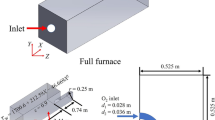Abstract
Having a background of utilising ammonia as an alternative fuel for power generation, exploring the feasibility of co-firing ammonia with methane is proposed to use ammonia to substitute conventional natural gas. However, improvement of the combustion of such fuels can be achieved using conditions that enable an increase of oxygenation, thus fomenting the combustion process of a slower reactive molecule as ammonia. Therefore, the present study looks at oxygen enriched combustion technologies, a proposed concept to improve the performance of ammonia/methane combustion. To investigate the characteristics of ammonia/methane combustion under oxygen enriched conditions, adiabatic burning velocity and burner stabilized laminar flame emissions were studied. Simulation results show that the oxygen enriched method can help to significantly enhance the propagation of ammonia/methane combustion without changing the emission level, which would be quite promising for the design of systems using this fuel for practical applications. Furthermore, to produce low computational-cost flame chemistry for detailed numerical analyses for future combustion studies, three reduced combustion mechanisms of the well-known Konnov’s mechanism were compared in ammonia/methane flame simulations under practical gas turbine combustor conditions. Results show that the reduced reaction mechanisms can provide good results for further analyses of oxygen enriched combustion of ammonia/methane. The results obtained in this study also allow gas turbine designers and modellers to choose the most suitable mechanism for further combustion studies and development.
Similar content being viewed by others
References
Grannell S.M., Assanis D.N., Bohac S.V., Gillespie D.E. The fuel mix limits and efficiency of a stoichiometric, ammonia, and gasoline dual fueled spark ignition engine. Journal of Engineering for Gas Turbines and Power. 2008, 130(4): 042802.
Natarajan S, Pitchandi K, Mahalakshmi N. Optimization of performance and emission characteristics of PPCCI engine fuelled with ethanol and diesel blends using grey-Taguchi method. Journal of Thermal Science. 2018, 27(1): 89–94.
Yin J, Weng Y, Zhu J. Numerical and experimental investigation on the performance of lean burn catalytic combustion for gas turbine application. Journal of Thermal Science. 2015, 24(2): 185–193.
IFRF, Combustion Industry News, 2016 [Online] http://www.mnm.ifrf.net/mnm/article.html?aid=1529 [Accessed 25th May 2016]
Baskar P, Senthilkumar A. Effects of oxygen enriched combustion on pollution and performance characteristics of a diesel engine. Engineering Science and Technology, an International Journal. 2016, 19(1):438–443.
Kardas D, Falkowska K. Reacting flow of hydrogen chloride and ammonia in experimental and numerical modelling. Journal of Thermal Science. 2003, 12(2): 188–192.
Li J, Huang H, Kobayashi N, He Z, Osaka Y, Zeng T. Numerical study on effect of oxygen content in combustion air on ammonia combustion. Energy. 2015, 93: 2053–2068.
Valera-Medina A, Marsh R, Runyon J, Pugh D, Beasley P, Hughes T, et al. Ammonia–methane combustion in tangential swirl burners for gas turbine power generation. Applied Energy. 2017, 185: 1362–1371.
Konnov A.A. Implementation of the NCN pathway of prompt-NO formation in the detailed reaction mechanism. Combustion and Flame. 2009, 156(11): 2093–2105.
Duynslaegher C, Jeanmart H. Kinetics in ammonia-containing premixed flames and a preliminary investigation of their use as fuel in spark ignition engines. Combustion Science and Techanology. 2009, 181: 1092–1106.
Kumar P, Meyer T.R. Experimental and modeling study of chemical-kinetics mechanisms for H2–NH3–air mixtures in laminar premixed jet flames. Fuel. 2013, 108: 166–176.
Hayakawa A, Goto T, Mimoto R, Arakawa Y, Kudo T, Kobayashi H. Laminar burning velocity and Markstein length of ammonia/air premixed flames at various pressures. Fuel. 2015, 159: 98–106.
Shmakov A.G., Korobeinichev O.P., Rybitskaya I.V., Chernov A.A., Knyazkov DA, Bolshova T.A., et al. Formation and consumption of NO in H2+O2+N2 flames doped with NO or NH3 at atmospheric pressure. Combustion and Flame. 2010, 157(3): 556–565.
Nozari H, Karabeyoğlu A. Numerical study of combustion characteristics of ammonia as a renewable fuel and establishment of reduced reaction mechanisms. Fuel. 2015, 159: 223–233.
Duynslaegher C, Contino F, Vandooren J, Jeanmart H. Modeling of ammonia combustion at low pressure. Combustion and Flame. 2012, 159(9): 2799–2805.
Sun W, Chen Z, Gou X, Ju Y. A path flux analysis method for the reduction of detailed chemical kinetic mechanisms. Combustion and Flame. 2010, 157(7): 1298–1307.
**ao H, Howard M, Valera-Medina A, Dooley S, Bowen PJ. Study on reduced chemical mechanisms of ammonia/ methane combustion under gas turbine conditions. Energy & Fuels. 2016, 30(10): 8701–8710.
David Goodwin H.M., Raymond Speth. Cantera: An object-oriented software toolkit for chemical kinetics, thermodynamics, and transport processes. http://www. cantera.org, 2016. Version 2.2.1.
Tian Z, Li Y, Zhang L, Glarborg P, Qi F. An experimental and kinetic modeling study of premixed NH3/CH4/O2/Ar flames at low pressure. Combustion and Flame. 2009, 156(7): 1413–1426.
Konnov A.A., Dyakov I.V., De Ruyck J. Probe Sampling Measurements of NO in CH4+O2+N2 flames Doped with NH3. Combustion Science and Technology. 2006, 178(6): 1143–1164.
Author information
Authors and Affiliations
Corresponding author
Additional information
This study is financially supported by the Welsh European Funding Office (WEFO) through its program “Flexible Integrated Energy Systems (FLEXIS)” (Grant No. 80835).
Rights and permissions
About this article
Cite this article
**ao, H., Wang, Z., Valera-Medina, A. et al. Study on Characteristics of Co-firing Ammonia/Methane Fuels under Oxygen Enriched Combustion Conditions. J. Therm. Sci. 27, 270–276 (2018). https://doi.org/10.1007/s11630-018-1008-1
Received:
Published:
Issue Date:
DOI: https://doi.org/10.1007/s11630-018-1008-1




